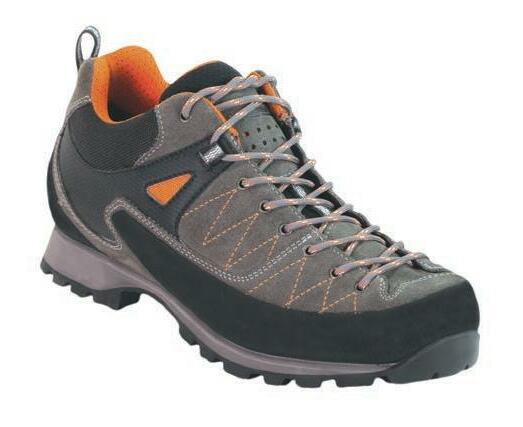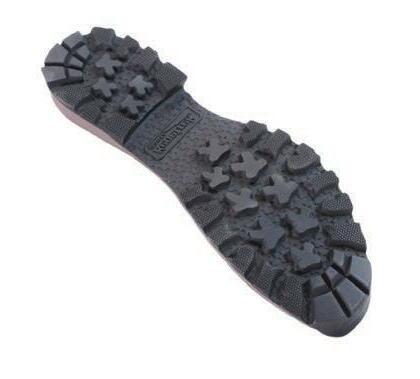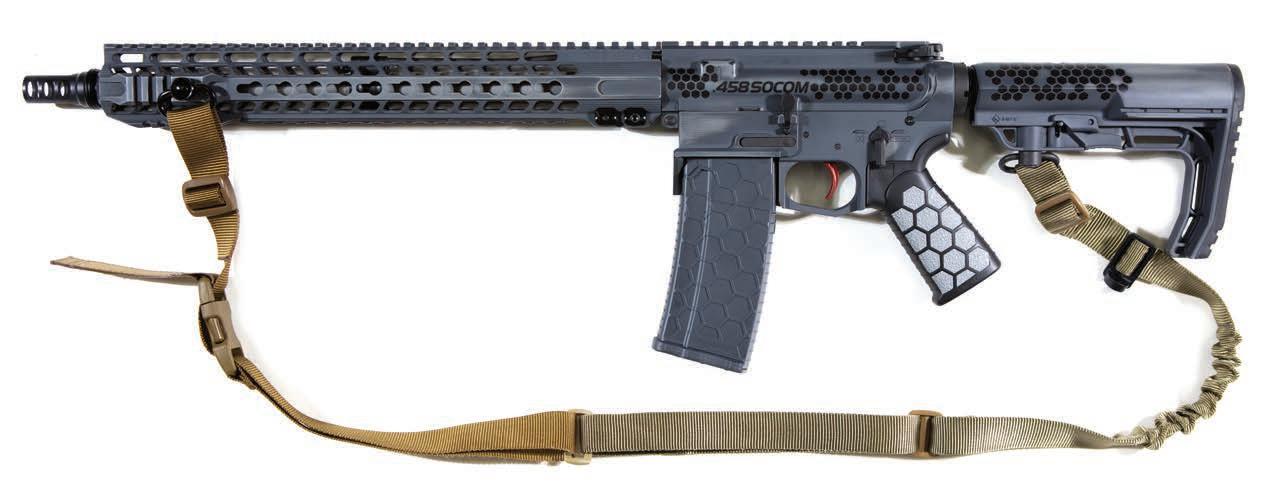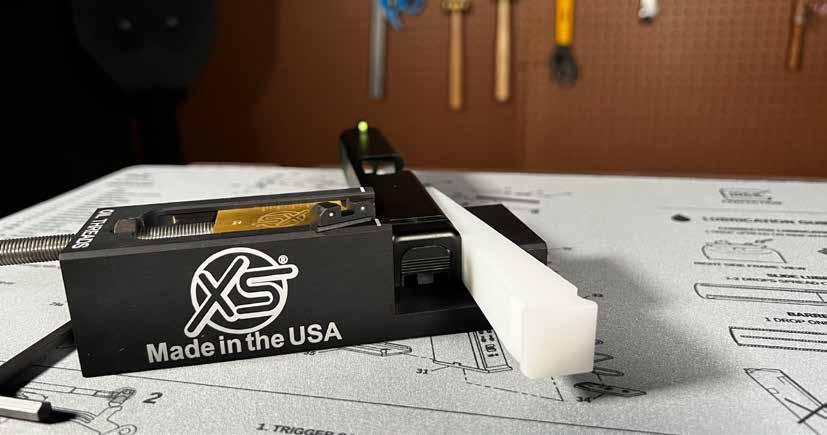
9 minute read
SELLING ESSENTIAL AR ACCESSORIES
Accessories SELLING ESSENTIAL AR
The AR platform accepts a wide range of aftermarket accessories. Here’s how to help a new owner get started.
by Fred Mastison
The AR-15 is one of the most modular firearms to ever exist. To many, it is an adult version of Legos. Our ability to modify and add on to this great gun is almost endless. From sights to lasers, there seems to be a spot for everything. In fact, the accessories market rivals the actual manufacturing side of this realm; hundreds of companies make components designed to appeal to owners of ARs. To many, the process can be overwhelming. This is especially true for the new gun owner. That’s where you come in. Your job is to help this new owner purchase and install accessories that will enhance their enjoyment of the gun. Based on my experience, the following six categories are the most requested accessories by new owners. They also happen to be some of the most essential and sensible accessories on the market.

STOCKS
Although a new AR will come with a stock, it may be a very simple and entry-level style. Many shooters opt for an aftermarket stock that fits them better. These can range from fixed old-school-style stocks to modern lightweight collapsible stocks with storage compartments. Of all the styles available, I encourage the use of a collapsible stock. It provides the user with the ability to adjust length of pull should they put on a heavy jacket or even a tactical vest. Aftermarket stocks are easily installed and will add a level of customization they will enjoy. The major players in this category include companies like Magpul (Booth #11660), Mission First (Booth #72948), and Hogue (Booth #14838). These stocks are not only high quality, but they come with solid brand recognition, making sales easier.
OPTICS
Optics are another great accessory. While iron sights are good, optics are better. When used
CUSTOMER FORUM
The following questions are typically asked of me in my training sessions. You will no doubt hear them as well.
Question: Can I put a light and a laser on my rifle? Answer: Yes, you can mount pretty much whatever you want on your new gun. In this case, I would seek out a unit that has both these features integrated into one unit. I try to keep the number of items on my rail to a minimum just to keep the weight down. The more you put on your gun, the more it will weigh. While it may seem like no big deal in the comfort of your home, you will notice the difference if you do a course with it.
Question: Are all optics equal? Answer: No. Optic quality can range from those intended for airsoft guns to glass built for special operations personnel. I would encourage you to take your time and buy the best quality optic you can. Good glass can be expensive, but you get what you pay for. A hasty purchase of a cheap optic just to get glass on the gun is almost always followed with regret. These cheap optics rarely hold zero well and are notorious for just dying on the range. I live by the motto, “Buy once, cry once.”
Question: Can I put a rifle stock on my AR15 pistol? Answer: The answer to this one is a huge no. AR15s are broken into two groups: rifles and pistols. An AR pistol is a pistol-length AR15 with no stock. In place of a stock, an AR pistol usually has a pistol buffer tube or similar piece that does not allow for the attachment of a traditional stock. To qualify as a pistol, there must be no vertical foregrip. Many people use “braces” in place of a traditional stock. The problem is that most, if not all, AR pistols have a barrel length of less than 16 inches, which is the minimum for rifles. If you put a stock on your pistol, the ATF considers the gun a short-barrel rifle and requires that it be registered through the NFA at a cost of $200. Possession of the modified pistol without the paperwork in line can cause legal issues.
Question: Can I put a competition trigger in my home defense rifle? Answer: While there is no official answer to this, I would advise against it. Most competition triggers are light and are designed to fire with little effort. In a self-defense-based gun, you want a standard trigger that provides sufficient resistance to avoid a negligent discharge. In short, you do not want to unintentionally fire the rifle after being startled. Having a self-defense-centered trigger can help you avoid a possible tragedy.
Question: Should I mount a bipod on my rifle? Answer: This depends on the application in which you will be using the rifle. A bipod is an excellent accessory that helps you stabilize the gun and, in turn, enjoy great accuracy. The downside is that they can be heavy and cumbersome. If you plan on doing a great deal of bench-type shooting where you are very focused on accuracy, then a bipod can be a good choice. If this is a standard fighting-rifle set up, I suggest you ditch the bipod. The extra weight outweighs the benefit that you would occasionally get from it. correctly add-on optics improve accuracy. As with all accessories, they range in style and price. Solid performers at reasonable prices are red-dot or holographic-style optics. These work well at the distances at which I find most new shooters working. These optics also have the benefit of being used with both eyes open, giving the user better awareness downrange.
There are also several manufacturers in this space, which keeps prices competitive, something your customer will appreciate. Although major players, such Aimpoint (Booth #13007), Trijicon (Booth #10735), Eotech (Booth #20049), and Leapers UTG (Booth #72305) are titans in this space, other smaller companies such as Burris (Booth #13227) and Sightmark (Booth #12270) are making a serious play for consumer dollars with good quality at a reasonable price point. You can also recommend Leupold (Booth #12421) as well.
LIGHTS
Lights are next on the list. Like the rest of the accessory market, the tactical or weapon light market is full of options. In general, I prefer LED models that can generate between 300 and 600 lumens. You can offer a light with a pressure switch or a toggle switch, depending on the needs and desires of the customer. For the longest time, these lights were run with lithium 123A-style batteries, but advancements in LED design have allowed more and more to use common AA or

Optics, whether a traditional scope or a red-dot or holographic-style, are always a welcome addition to this platform.
AAA batteries. I am a fan of this development simply because of the ready availability and low cost of AAs or AAAs. Surefire (Booth #12270) and Streamlight (Booth #11468) are both well-respected brands with a vast catalog of light options.
HANDGUARD

The handguard on the rifle is another area where I see many people make a change after they get their rifle. Some rifles come with plainJane plastic handguards, which limit the ability to add items in the front of the gun. There tends to be two major schools in this area; some prefer KeyMod-style holes for accessories; others use MLOK-style attachment slots. The choice is really up to your customer, as there are adapters readily available on the market. But in my experience, if I were forced to choose one, I would lean toward MLOK because I have found it to be very stable. Here, I believe you can’t go wrong with Magpul.
TRIGGERS
The factory trigger will be adequate for most shooters. However, upgrading to a mil-spec trigger almost always offers immediate performance improvements. The trigger market is deep and wide with options ranging from cassette-style units that are self-contained and just drop in to traditional units. They can also vary in poundage from feather-light competition units to mil-spec weights. Ultimately, help the customer select the trigger that best serves their most common use. Companies like Trigger Tech (Booth # 42713), CMC Triggers (Booth #70123), Rise Armament
A Blackhawk Knoxx adjustable buttstock allows the user to adjust length of pull.
(Booth #70843), and Blackout Defense (Booth #75424) are leaders in this space, with more joining the field every day.
SLINGS
A good rifle sling is something I consider an essential accessory. It can be used to carry a rifle as well as provide stability when lining up a
©KENETREK, LLC 2023

Bridger low






VISIT US AT BOOTH 41916
You know that feeling… when your feet barely touch the ground as you glide over uneven terrain… and whether you’re racing across trails or running errands, super-light and exceptionally tough gets you there without a care in the world. With bedrock support and weighing in at just over two pounds, these water tight, easy-breathing boots will be your best friend through the summer.
WWW.KENETREK.COM | 800-232-6064
YOU’RE INVITED





ALIENGEARHOLSTERS.COM
PRODUCT LAUNCH PARTY
Beer & Snacks Tuesday, 17TH 1:30-3:00pm CHECK IT OUT TODAY! BOOTH #10174 | 2ND FLOOR Booth #10174 2ND Floor

shot. Like all the other items in our accessory search, there are many options. The two most common versions are the single-point and the two-point sling. The names are self-descriptive; the single-point connects to the gun at one point while the two-point connects at two different spots. The single-point is popular because it allows easy manipulation of the gun on both sides of the body. The downside is that the gun tends to swing a lot when you are moving. I prefer a two-point sling. This version keeps the gun more stable, but requires some practicing when transitioning from strong- to support-side shooting. There is a design and color to fit the needs and desires of any shooter. One of the best on the market comes from Blue Force Gear (Booth #20405). Their Vickers sling is well made and also well known in the serious shooting community. Sentry Products Group (Booth #72605) and Blackhawk (Booth #11838) are also good choices.
The Sentry Products Group two-point sling helps stabilize the gun when on the move.

DIY-Series™ Sight Pusher Install Kit for Glock®
Designed by Gunsmiths for the DIYer™. 50% less install force than typical pushers.

Stop by booth 13624 to demo the tool!





